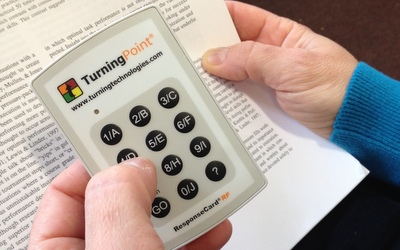 Origin
OriginDepartment of Electrical & Electronic Engineering, Faculty of Engineering, University of Bristol
Learn more about student response systems and equipment available for loan.
Dr Mike Barton, M.H.Barton@bristol.ac.uk
About 100 first-year students from three different Engineering programmes take the Digital Circuits and Systems lecture course. Rather than presenting material for the first time in lectures, Mike decided to move switch to a 'pre-loaded' approach: asking students to read the material before coming to the lecture. Mike needed a method to ensure that students actually did the reading - which is where e-voting came in.
Mike added voting slides to his presentations using the Turning Point software. In lectures each student was given a voting keypad. Their responses to the questions were automatically collated and displayed graphically during the lecture.
Using e-voting, students get instant feedback on their answers. They can also compare their performance to the rest of the class - motivating the students to keep up with their peers. e-Voting can be used anonymously, so only the individual student knows what their response was. However it is also possible to get students to identify themselves by entering their student number. The data can be downloaded and saved as an Excel spreadsheet at the end of the lecture, with responses matched up to individual students.
Turning Point also contains the facility to create rankings and leader boards. This has proved very popular with students on this lecture course, with strong competition between the different degree programmes.
Students say they really like the e-voting and want to see it used in more lectures. They appreciate getting regular feedback on how they are doing, as well as the increased participation in lectures.
The lecturer also benefits from instant feedback on whether students have understood the reading. Lectures can then be adjusted to focus on areas where students are struggling.
Student attendance has improved since the introduction of e-voting. In previous years attendance dropped off to around 60-70% over the course of lectures. Now attendance remains around 90% throughout.
Mike found that the benefits from e-voting came from integrating it with the rest of the teaching material, rather than treating it as an add-on or gimmick. It is important to get the balance right - it does not necessarily work best included in every lecture but it is important to use it consistently.
In practical terms, the Turning Point equipment is very reliable. However it is helpful to include a 'tester' question at the start of each lecture to check all the handsets are working. Distribution and collection of handsets did not prove to be as time-consuming as Mike was expecting. He asks students at the end of each row to take responsibility for the whole row's handsets. However Mike has chosen to move to a 2 hour lecture slot (rather than two 1-hour slots) to reduce the proportion of time spent distributing equipment even further.